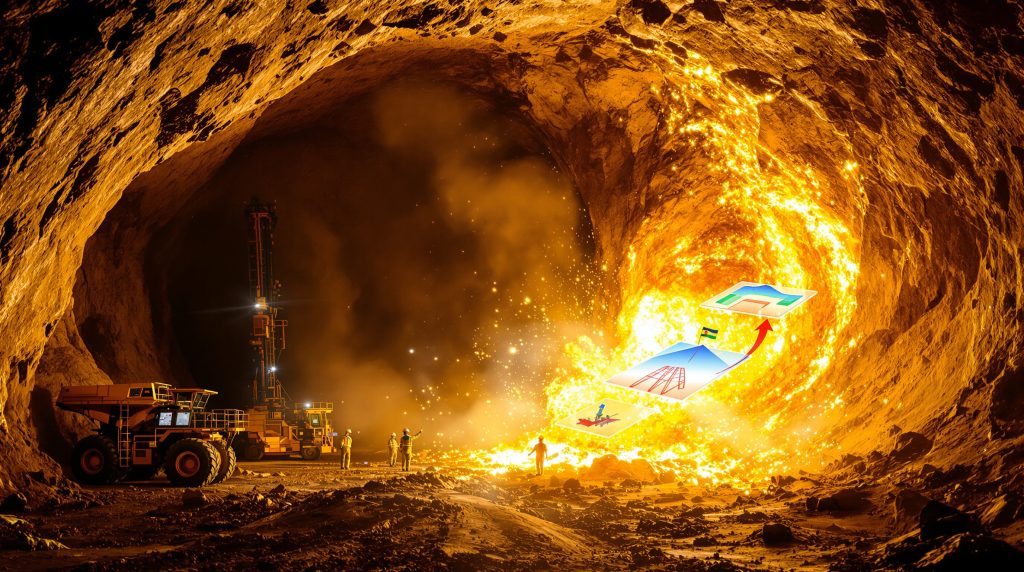Understanding Blasting Operations at Loulo-Gounkoto Mine
Blasting operations at the Loulo-Gounkoto gold mine complex represent a critical component of the extraction process, combining technical expertise with strict safety protocols. These operations involve carefully controlled explosions designed to fracture rock formations and access gold-bearing ore deposits. Following a complex legal standoff between Barrick Mining and Mali's military-led government, the mine is now preparing to resume its blasting activities after a significant operational pause.
The process requires specialized equipment, trained personnel, and meticulous planning to ensure both operational efficiency and workplace safety. Understanding these operations provides insight into the technical complexity of modern gold mining and the challenges faced by mining companies operating in politically complex environments.
What Are the Key Elements of Blasting Operations at Loulo-Gounkoto?
Blasting at Loulo-Gounkoto involves sophisticated technical components designed specifically for the geological conditions encountered at the mine site. These tailored approaches are essential for maximizing ore recovery while ensuring operational safety and environmental protection.
Technical Components of Mining Blasts
The technical elements of blasting operations involve a careful balance of explosive selection, drilling patterns, and timing sequences:
-
Explosive Selection and Placement: Engineers select specific explosive compounds based on the unique characteristics of the rock formations, including hardness, fracture patterns, and surrounding environmental considerations.
-
Drilling Patterns: The mine utilizes customized hole arrangements specifically designed to optimize ore recovery while minimizing the amount of waste rock produced.
-
Timing Sequences: Blasting engineers implement precisely calculated detonation timing sequences that effectively control vibration levels and substantially improve fragmentation quality.
-
Blast Design Software: The mine employs advanced modeling programs that can simulate blast outcomes before implementation, allowing for refinements and adjustments to maximize effectiveness.
Safety Protocols and Environmental Considerations
Safety remains paramount in all blasting operations at Loulo-Gounkoto:
-
Exclusion Zones: Standard protocols include establishing safety perimeters during all blasting activities to prevent personnel exposure to potential hazards.
-
Vibration Monitoring: The operation conducts continuous measurement of ground vibrations to prevent structural damage to mine infrastructure and nearby facilities.
-
Dust Suppression Systems: Water-based solutions are deployed to reduce airborne particulates, protecting both workers and surrounding environments.
-
Community Notification Procedures: The mine maintains advanced warning systems for nearby settlements, providing notice periods before scheduled blasting activities.
How Has the Legal Dispute Affected Blasting Operations?
The resumption of blasting operations at Loulo-Gounkoto follows a complex legal standoff between Barrick Mining and Mali's military-led government. This dispute has significantly impacted mining activities and created uncertainty about the mine's future operational status.
Timeline of Operational Disruptions
The dispute has caused substantial disruption to normal mining operations:
-
January 2025: Initial suspension of mining operations following disagreements over Mali's new mining code, which proposed increased taxes and greater state ownership of mining assets.
-
June 2025: Court appointment of a provisional administration led by former Health Minister Soumana Makadji to oversee operations.
-
June-October 2025: Activities were limited to processing existing ore stockpiles, with no new ore extraction occurring.
-
October 15, 2025: Scheduled resumption of underground blasting operations, marking a potential turning point for the mine.
Financial Impact of Operational Pause
The operational suspension has had far-reaching economic consequences:
-
Production Limitations: Approximately 1.07 tonnes of gold were produced from existing stockpiles during the suspension period, significantly below normal production rates.
-
National Economic Effect: Mali's industrial gold production decreased by 32% year-on-year to 26.2 tonnes by August 2025, according to documents from the mines ministry.
-
Revenue Implications: The disruption caused significant reduction in both corporate profits and government tax receipts, affecting multiple stakeholders.
-
Subcontractor Challenges: The dispute created payment delays affecting key service providers, including Sandvik and Maxam, whose services are essential for blasting operations.
What Makes Loulo-Gounkoto's Blasting Operations Unique?
The Loulo-Gounkoto complex employs distinctive blasting methodologies tailored to its specific geological conditions. These approaches are carefully designed to address the particular challenges of the local rock formations while maximizing gold recovery.
Advanced Blasting Technologies
The mine utilizes several advanced technologies to optimize blasting outcomes:
-
Electronic Detonation Systems: Precision timing devices that significantly improve fragmentation quality compared to traditional methods.
-
3D Blast Modeling: Computer simulations that optimize explosive energy distribution throughout the rock mass, leading to more predictable and efficient blasting results.
-
Seismic Monitoring Network: Real-time vibration tracking systems with monitoring stations strategically placed around the mine perimeter.
-
Automated Drilling Rigs: Computer-controlled equipment that ensures precise hole placement and depth, critical for optimal blast performance.
Underground vs. Open-Pit Blasting Differences
The Loulo-Gounkoto complex includes both underground and open-pit operations, each with distinct blasting requirements:
| Aspect | Underground Operations | Open-Pit Operations |
|---|---|---|
| Blast Size | Smaller, more frequent blasts | Larger, less frequent blasts |
| Explosive Types | Primarily emulsion-based | ANFO and emulsion blends |
| Ventilation Requirements | Extensive air clearing systems | Natural air dispersion |
| Ground Support Needs | Immediate reinforcement post-blast | Less immediate support required |
| Environmental Containment | Fully contained within tunnels | Dust and vibration management over larger areas |
What Are the Economic Implications of Resumed Blasting?
The restart of blasting operations represents a potential turning point for both the mine's productivity and Mali's broader mining sector. However, significant challenges remain in resolving the underlying dispute between Barrick and the Malian government.
Production Recovery Potential
The resumption of blasting offers significant potential for production recovery:
-
Processing Capacity: The current mill is capable of processing substantial amounts of ore when operating at full capacity.
-
Gold Recovery Rates: Historical recovery efficiency at the processing facility has been consistently high, allowing for effective gold extraction from the mined ore.
-
Grade Variability: Underground operations typically access higher-grade ore compared to open pit areas, affecting the overall economics of the operation.
-
Expansion Plans: Future processing capacity increases remain possible but are contingent on resolving the current dispute.
Ongoing Negotiation Challenges
Several key issues continue to complicate negotiations:
-
Ownership Structure: The current arrangement with Barrick holding an 80% stake and the Mali government 20% is central to the dispute.
-
Mining Code Revisions: Government proposals for increased taxes and greater state participation have been a major point of contention.
-
International Arbitration: A pending World Bank arbitration court ruling expected in late October 2025 could significantly impact the resolution process.
-
Stakeholder Concerns: Community and investor uncertainty regarding long-term operational stability continues to affect confidence in the operation.
How Do Blasting Operations Impact Local Communities?
The resumption of blasting activities has significant implications for communities surrounding the Loulo-Gounkoto complex. These impacts extend beyond economic considerations to include environmental, social, and safety dimensions.
Community Engagement Practices
The mine has established several programs to manage community relations:
-
Notification Systems: Advanced warning protocols for scheduled blasting activities help minimize disruption to local communities.
-
Employment Opportunities: Mining operations support thousands of direct and indirect jobs connected to full operational status.
-
Infrastructure Development: Community projects including road maintenance and water access improvements provide tangible benefits to local populations.
-
Educational Initiatives: Training programs for local residents in mining-related skills help build capacity within surrounding communities.
Environmental Management Strategies
Environmental considerations are integrated into blasting operations through several approaches:
-
Water Quality Monitoring: Regular testing of groundwater and surface water for potential contamination helps protect local water resources.
-
Dust Control Measures: Sprinkler systems and binding agents are employed to reduce airborne particulates resulting from blasting activities.
-
Noise Mitigation: Sound barriers and scheduling adjustments aim to minimize community disturbance from blasting operations.
-
Rehabilitation Planning: Progressive reclamation planning innovations following mining activities helps restore the natural environment.
What Technical Challenges Face Blasting Operations?
Resuming blasting operations after a prolonged suspension presents unique technical challenges that must be addressed to ensure safe and efficient operations.
Equipment Readiness Assessment
Several aspects of equipment readiness must be addressed:
-
Drilling Fleet Maintenance: Comprehensive inspection and servicing of drill rigs after the operational pause is essential for safe and effective operation.
-
Explosive Storage Conditions: Verification of proper storage conditions for blasting agents and accessories is critical to maintain their stability and effectiveness.
-
Monitoring System Calibration: Recertification of vibration and air blast monitoring equipment ensures accurate measurement of blasting impacts.
-
Support Infrastructure: Evaluation of ground support systems in previously active mining areas is necessary to prevent ground instability issues.
Personnel and Training Requirements
The human element is equally important when restarting blasting operations:
-
Safety Refresher Training: Mandatory retraining for all personnel involved in blasting activities helps ensure proper procedures are followed.
-
Procedure Review: Comprehensive assessment of existing blasting protocols and potential improvements can enhance operational safety and efficiency.
-
Emergency Response Preparedness: Updated evacuation and incident management procedures are essential for effective response to potential emergencies.
-
Regulatory Compliance: Verification of adherence to current Malian mining regulations and international standards is necessary for legal operation.
What Future Developments Are Expected for Loulo-Gounkoto Blasting?
Looking beyond the immediate resumption of operations, several developments are anticipated that could shape the future of blasting activities at the Loulo-Gounkoto complex.
Technological Innovations
Several technological advancements could enhance future blasting operations:
-
Autonomous Drilling Systems: Potential implementation of self-operating drill rigs to improve precision and safety represents a significant advancement opportunity.
-
Real-Time Fragmentation Analysis: Camera-based systems that provide immediate feedback on blast effectiveness could optimize subsequent blasting designs.
-
Advanced Modeling Software: Enhanced simulation capabilities for optimizing blast designs would allow for more precise control of blast outcomes.
-
Alternative Explosive Formulations: Exploration of more environmentally friendly blasting agents could reduce the environmental footprint of mining operations.
Regulatory and Governance Evolution
The regulatory environment continues to evolve:
-
Mining Code Implementation: Adaptation to new regulatory requirements following dispute resolution will shape operational parameters.
-
Transparency Initiatives: Enhanced reporting on operational activities and environmental impacts may become standard practice.
-
Community Participation: Greater involvement of local stakeholders in operational planning could become increasingly important.
-
Sustainability Certification: Pursuit of international standards for responsible mining practices may become a priority as operations stabilize.
Balancing Technical Excellence with Stakeholder Interests
The resumption of blasting operations at the Loulo-Gounkoto gold mine represents more than just a technical milestone. It embodies the complex interplay between resource extraction, government oversight, community interests, and corporate strategy. As operations restart, the success of blasting activities will depend not only on technical excellence but also on effective stakeholder engagement and regulatory compliance.
The mine's ability to balance these competing demands will likely determine whether it can return to its previous status as one of Mali's premier gold prices analysis contributors. With continued dialogue between Barrick Mining and Mali's government, alongside transparent community engagement, there remains potential for the Loulo-Gounkoto complex to establish a sustainable operational model that benefits all stakeholders while maintaining world-class blasting practices.
Readers interested in learning more about mining operations in West Africa can also explore mining legal challenges that affect regional development, or examine how drill results interpretation informs operational decisions. Furthermore, understanding modern mine planning practices can provide additional context on how complex operations like Loulo-Gounkoto manage their activities for optimal outcomes.
Want to Spot the Next Major Mineral Discovery?
Discovery Alert's proprietary Discovery IQ model delivers real-time notifications on significant ASX mineral discoveries, empowering you to identify actionable opportunities before the broader market. Explore why historic discoveries generate substantial returns by visiting Discovery Alert's dedicated discoveries page and begin your 30-day free trial today.




